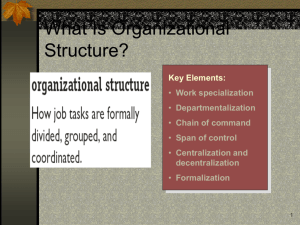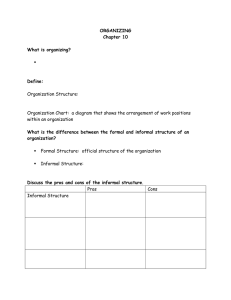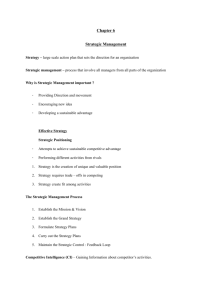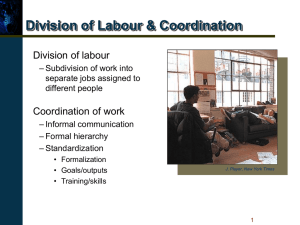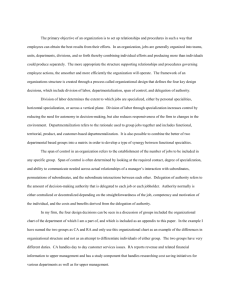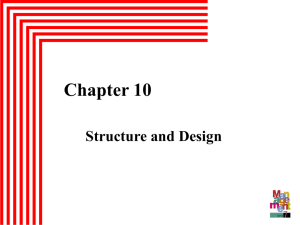Organizational Structure
advertisement
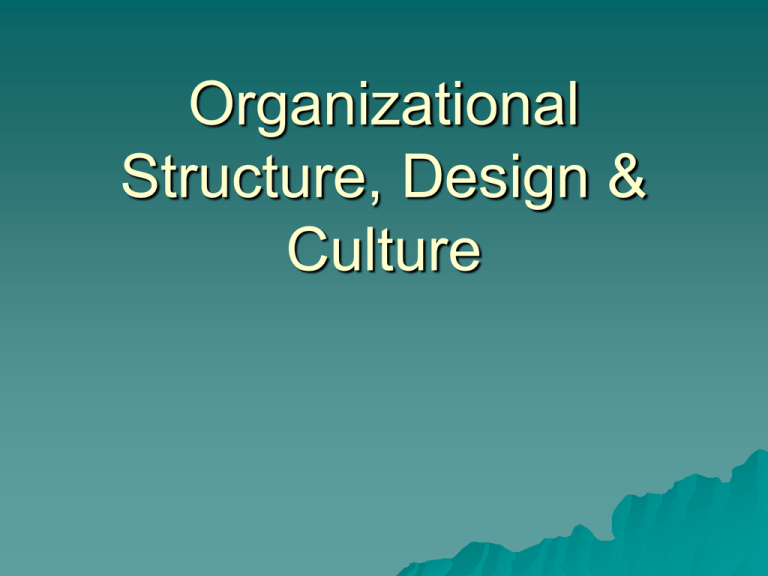
Organizational Structure, Design & Culture Organizational Structure How job tasks are formally divided, grouped, & coordinated Why? – Meet goals & objectives of organization – Efficiency & effectiveness Organizational Structure 6 elements to address for a proper organizational structure 1. 2. 3. 4. 5. 6. Work specialization Departmentalization Chain of command Span of Control Centralization or decentralization Formalization Organizational Structure 1. Work specialization – Division of labor Tasks are subdivided into separate jobs – Jobs broken into steps with multiple people doing their individual part to make the entire product – Assembly lines, McDonald’s Organizational Structure 1. Work specialization – Advantages Used to increase productivity Allows skill building on the job – Disadvantages Good to a point & then diminishing returns Boredom, absenteeism, stress, high turnover Organizational Structure 2. Departmentalization – Grouping of jobs according to (4): Function/process Product Geography Customer Organizational Structure 2. Departmentalization – Grouping of jobs according to (4): Function/process – Northwest SRA Managers: Inclusion, cultural arts, special events – Pocono Family YMCA Organizational Structure 2. Departmentalization – Grouping of jobs according to (4): Product – Nike: Golf, shoes, clothing – REI: Clothing & footwear, snow gear, water gear, land gear Geography – NRPA regions; NPS – Gametime – 18 independent U.S. Reps – NWSRA – 2 area (by city) inclusion coordinators Organizational Structure 2. Departmentalization – Grouping of jobs according to (4): Customer – retail, wholesale, government – corporate vs. individual clients – NRPA (Aquatics, L & A, CBM, NTRS) Organizational Structure 3. Chain of command – Unbroken line of authority the right to exercise influence, give directives or make certain decisions within the organization Organizational Structure 3. Chain of command – Key issues Unity of Command – 1 supervisor ee is responsible to Seeing less chain of command with empowerment – More access to company wide info via technology – Don’t need to have your boss talk to the boss of maintenance to get the grass mowed! Organizational Structure 4. Span of Control – # of people, units, & operations a mgr can control effectively & efficiently – Small span of control – supervise smaller number of people – Larger span of control – supervise larger number of people Organizational Structure 4. Span of Control – # of people, units, & operations a mgr can control effectively & efficiently – Small span of control – supervise smaller number of people – Larger span of control – supervise larger number of people Organizational Structure 4. Span of Control – See smaller span of control at top & larger at bottom of org. – 7 is optimal but depends on work done – Which is better? Smaller or larger? Organizational Structure 4. Span of Control – Wider – fewer managers, more ee’s reporting to them Reduces cost, speeds decision making Get closer to the customer Empower employees Fewer layers of employees Invest in training staff – Easier to supervise a lot of good staff than bad ones Organizational Structure 4. Span of Control – Smaller – more managers with fewer ee’s Tight managerial control Increase cost of managers Added managers slows communication Encourages micro-managing & discourages ee autonomy Organizational Structure 5. Centralization or decentralization – Degree to which decision making is concentrated at a single point in the organization Organizational Structure Centralization – Top managers make all the decisions – Consistency in decision making – Slow process…move up the chain of command Organizational Structure Decentralization – Decision making is pushed down to mgrs closest to the action – Quicker actions taken – More people provide input – EE’s less likely to feel alienated from decision makers – Mgrs closer to situation Organizational Structure 5. Centralization or decentralization – ???? – Which one is better? – Is there a place for both? Organizational Structure 6. Formalization – Degree to which jobs are standardized – EE has minimal discretion in how, what & when to do things – Policies are strictly followed – Explicit job descriptions – Less formalization increases freedom Organizational Design Simple Structure Bureaucracy Team Based Structure Matrix Structure Organizational Design How organizational structures are arranged and incorporated Designs change as people come & go in the organization Organizational Design Simple structure – Low degree of departmentalization, wide span of control, centralized authority, little formalization – “Flat” organization Organizational Design Simple structure – Fast, flexible, inexpensive, clear accountability – Info overload at the top – Difficult to use in a large organization KNR Director Athletic Training Faculty Exercise Physiology Faculty PETE Faculty RPA Faculty Organizational Design Bureacracy – Highly standardized operating tasks achieved through specialization – Formalized rules – Tasks grouped by function – Centralized authority – Narrow span of control – Decision making follows the chain of command Organizational Design Bureacracy – Strength – ability to perform standardized activities efficiently – Functions well with less talented & less costly ee’s – Resistant to change – Close adherence to rules, minimizes decision making – Put like minds together Bureaucracy Organizational Design Team Based Structures – Breaks down dept barriers – Org is more horizontal – Decentralizes decision making to team level – Requires ee’s be generalists vs. specialists – Naperville Park District Organizational Design Team Based Structures – Self managed teams Work together to accomplish goals & obj. Marketing team Treatment team – Problem solving teams Short term to solve problems Groups vs. Teams Organizational Design Matrix Structure (cross functional teams) – Combines functional & product departmentalization – Assigns specialists to specific functional departments to work with interdisciplinary groups led by project leaders – Breaks unity of command concept 2 bosses – functional dept manager & product managers Home Departments: Marketing Accounting Registration Human resources Arts Events Sports Recreation Maintenance Reading Org Charts Lines show chain of command Levels should be similar Determine distinction between titles: – Manager, supervisor, coordinator, specialist, leader
